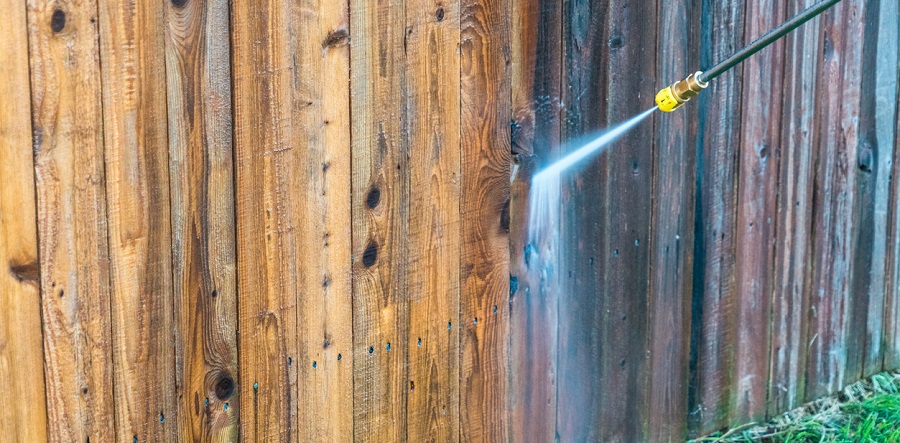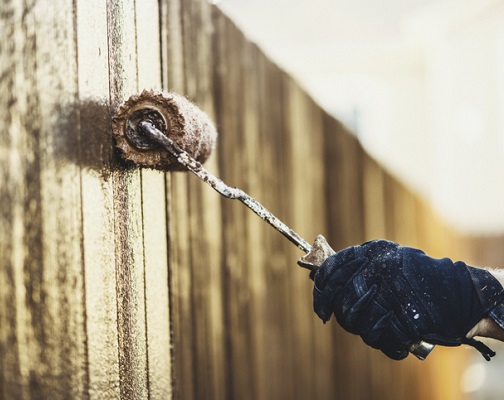How To Paint Fence Panels – Answering The Key Questions
Reading time: 5 minutes
Can you paint pressure treated fence panels?
Now that you understand the benefits of painting fence panels, next we will go through some techniques to consider when providing this service to your customers.
Let us begin with painting pressure treated fence panels. This type of fencing will already have gone through a preservative anti-rot treatment and a newly installed fence probably will not need painting immediately, due to the chemical residue.
It is possible to paint new pressure treated fencing for decorative purposes though, but only after it has had time to weather for a short time. The fence panels must be completely dry before you start the work too.
The fencing needs to be cleaned so that there is no mould, chemical residues or dirt present as well, otherwise this will affect the look of the painted panels.
Painting older pressure treated fence panels every few years is a cost-effective way to protect against rot, reducing the need to replace decaying fence panels.
Whatever the scenario, make sure to check the manufacturer’s guidance before starting the work to ensure the paint product is suitable for pressure-treated wood.
Can you use masonry paint on fence panels?
While masonry paint is usually used to protect a property’s exterior walls from the weather, it can also be used on garden fence panels in some instances. Just be sure to check the manufacturer’s guidance about the product’s suitability on wood due to the breathability of this paint type, compared to one specifically for wood.
Where this technique is possible, the masonry paint should be mixed with the appropriate adhesion primer so that the paint can bond better with the wood. Bear in mind that some paints are water-based and others are solvent-based when deciding on the amount of primer to be used. The primer will also be applied for thinning purposes of the first coat, due to masonry paint being thicker than traditional fence paint.
Old paint should be completely sanded and removed from the panels before masonry paint is applied as well, with the surface of the fencing clear of any mould or moss too.
Can you paint wet fence panels?
The weather really can affect the process of painting fence panels, as the answers to the next two questions will highlight.
A fence should not be painted on when it is wet, as this can completely spoil the finish. You should wait a day or two after it has rained to start this work, so that the fencing has enough time to dry.
Just avoid painting panels in very hot weather or extremely humid conditions. These periods of high temperatures can see paint drying onto fencing quicker than you would like, with quality suffering as a result.
Can you paint fence panels in winter?
Painting a fence during the winter months can have its benefits, such as the task being made easier when you will not need to work around plants and flowers in full bloom. Property owners are sure to enjoy their garden being injected with some colour when the weather is dark and bleak.
However, you will be putting a lot of trust in the unpredictable nature of the British weather by carrying out this task in the winter.
Fence paint will take longer to dry in colder weather, so you will be needing to check the forecast and making sure rain is not due that can ruin your work. Paint can also change its texture and consistency when a fence freezes overnight, which can cause it to peel or crack.
How should I prepare fence panels for painting?
Before you start painting fence panels, make sure any debris or dirt is removed from the fencing using a stiff brush.
You can also use this brush to get rid of flaking bits of old paint if the fence has previously been painted, though you may need to sand the fencing in places first to lift some of the old paint.
A pressure washer will be ideal for getting rid of any stubborn grime too, though the fencing will then need to be given time to dry thoroughly before it is painted.
Nails and screws which are not keeping the fence together, but were previously keeping the likes of climbing plants secure, should be pulled out of the fencing if they are sticking out as well before any painting is started. This is to avoid these items becoming a hazard when you are working.
Working with garden fencing designed with concrete or non-wood posts? Avoid getting paint on these by masking them off using tape and paper.

How long does it take to paint a fence panel?
If you charge for your trade services by the hour, take note of the standard timings to achieve a high-quality finish depending on your preferred method:
-
A fence panel should take between 15 minutes and 30 minutes to paint using only a brush.
-
A fence panel should take between ten minutes and 20 minutes to paint with the combination of a roller and a brush.
-
A fence panel should take between one minute and five minutes to paint using a sprayer.
There are plenty of reasons to offer fence painting as part of your professional gardening services then, as well as various techniques for approaching this work. Just make sure you are always checking a paint manufacturer’s instructions and guidance before carrying out any job, to ensure the product is suitable for the application.
We have many more in-depth guides and helpful tips on how to enhance your services when working in a property’s exterior space within our excellent gardens and landscaping advice hub.




